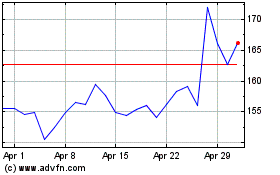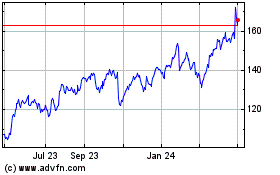Inside ZTE's Phone, a Glimpse of China's Dependence on U.S. Tech
May 18 2018 - 5:59AM
Dow Jones News
By Dan Strumpf
A peek inside ZTE Corp.'s flagship smartphone reveals how
heavily the Chinese telecom giant depends on U.S. technology
suppliers -- and stresses the urgency of ZTE's efforts to strike a
deal with U.S. commerce chiefs that would lift the ban on U.S.
exports.
U.S. companies supply 60% of the electronic components in ZTE's
Axon M smartphone, according to ABI Research Inc., a
market-forecasting firm.
San Diego-based chip maker Qualcomm Inc. is the biggest
supplier, with at least eight of 25 key components on the device's
main circuit board originating with it, according to ABI. Those
parts include the modem, which connects the phone to the internet,
and the power management unit, which directs the flow of power
through the device.
Other components come from SanDisk Inc., a flash-memory supplier
based in Milpitas, Calif., and Skyworks Solutions Inc., a Woburn,
Mass., chip maker, ABI found. The protective glass on the phone's
display is supplied by Corning Inc., the Corning, N.Y.-based maker
of Gorilla Glass, which is also used in Apple Inc. devices.
None of these companies has been able to export parts to ZTE
since the Commerce Department's mid-April order barring U.S. sales
of products to ZTE. The U.S. imposed the penalty on ZTE for its
violation of a 2017 settlement resolving a probe into its evasion
of U.S. sanctions on Iran.
ZTE, based in the southern Chinese tech hub of Shenzhen, has
told the U.S. government that its failure to comply with the
settlement was due to failures in internal controls, according to a
person familiar with the matter.
The export ban has been devastating for ZTE, which has shut down
its major business operations. The company is now a political pawn
in the U.S.-China trade dispute, and its fate likely hinges on the
outcome of trade negotiations this week between the two sides in
Washington, D.C. President Donald Trump early this week tweeted
that he would try to get ZTE back in business; Commerce Secretary
Wilbur Ross said he was looking at alternative punishments.
Even if other measures were to happen swiftly and exports
resumed, the damage to ZTE's business is likely to endure. ZTE
suppliers and customers have been re-evaluating their business
ties. Telstra Corp., Australia's largest telecom operator, stopped
selling ZTE handsets over concerns about supply, while MTN Group
Ltd., Africa's biggest operator, has also stopped carrying ZTE
phones.
"ZTE needs to try everything to reach a settlement with the U.S.
government," said Mo Jia, an analyst at Canalys, a mobile-device
research firm. "if it fails, it would be extremely hard for ZTE to
carry on its smartphone business."
A ZTE spokeswoman didn't immediately respond to a request for
comment.
Like many global tech firms, ZTE relies on an interconnected web
of suppliers to build its devices. U.S. companies like Qualcomm
dominate the market for smartphone chips and other high-end phone
parts. In the first quarter, 84% of the phones shipped by ZTE
contained Qualcomm chipsets, according to Canalys.
ZTE phones run on the Android operating system, provided by
Alphabet Inc.'s Google. The Commerce Department ban means Google
has stopped providing software updates and other services to ZTE,
according to a person familiar with the matter. Many ZTE phone
users say their devices have become glitchy and unreliable in
recent weeks.
At the same time, the U.S. market is crucial to ZTE. Its phones
are also-rans in China, where ZTE has lost out to domestic rivals.
In the U.S., it is the fourth-largest vendor of mobile phones,
after Apple Inc., Samsung Electronics Co. and LG Electronics Inc.,
according to Canalys.
Almost three-fourths of all ZTE's first-quarter smartphone
shipments were in the U.S., where it is a big player in the budget
and midtier phone segments, the research company said.
--Joe Parkinson contributed to this article.
Write to Dan Strumpf at daniel.strumpf@wsj.com
(END) Dow Jones Newswires
May 18, 2018 05:44 ET (09:44 GMT)
Copyright (c) 2018 Dow Jones & Company, Inc.
Alphabet (NASDAQ:GOOGL)
Historical Stock Chart
From Dec 2024 to Jan 2025

Alphabet (NASDAQ:GOOGL)
Historical Stock Chart
From Jan 2024 to Jan 2025
